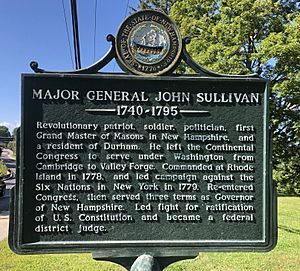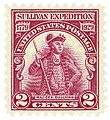John Sullivan (general) facts for kids
Quick facts for kids
John Sullivan
|
|
|---|---|
 |
|
| Judge of the United States District Court for the District of New Hampshire | |
| In office September 26, 1789 – January 23, 1795 |
|
| Appointed by | George Washington |
| Preceded by | Seat established by 1 Stat. 73 |
| Succeeded by | John Pickering |
| 3rd & 5th Governor of New Hampshire | |
| In office January 22, 1789 – June 5, 1790 |
|
| Preceded by | John Langdon |
| Succeeded by | Josiah Bartlett |
| In office June 7, 1786 – June 4, 1788 |
|
| Preceded by | John Langdon |
| Succeeded by | John Langdon |
| Personal details | |
| Born |
John Sullivan
February 17, 1740 Somersworth, Province of New Hampshire, British America |
| Died | January 23, 1795 (aged 54) Durham, New Hampshire |
| Resting place | Durham, New Hampshire |
| Children | George Sullivan |
| Relatives | James Sullivan |
| Education | read law |
| Signature | |
John Sullivan (born February 17, 1740, in Somersworth, New Hampshire – died January 23, 1795, in Durham, New Hampshire) was an important American general during the American Revolutionary War. He also served as a delegate in the Continental Congress, which was the government of the American colonies during the war.
Sullivan was a major general in the Continental Army, the main army of the American colonies. He also became the Governor (or "President") of New Hampshire. He is well-known for leading the Sullivan Expedition in 1779. This was a military campaign against certain Iroquois towns that had supported the British.
Contents
Early Life and Career
John Sullivan was the third son of a schoolmaster. He studied law with Samuel Livermore in Portsmouth, New Hampshire. In 1764, he started his own law practice in Durham. At first, he wasn't very popular because he was the only lawyer in town and handled many lawsuits.
However, by 1772, he had become a respected member of the community. He was chosen by Durham to represent them in the colony's general assembly. He even became friends with the royal governor, John Wentworth.
As the American Revolution got closer, Sullivan began to support the American rebels. In 1774, he was chosen as a delegate for the first Provincial Congress. This group represented the rebels. He was sent to the Continental Congress.
In 1775, he returned to the Congress. But when they made him a brigadier general in June, he left to join the army. He helped with the siege of Boston, where American forces surrounded the British.
Fighting in the Revolutionary War
After the British left Boston in the spring of 1776, General George Washington sent Brigadier General Sullivan north. He was to take command in Quebec after the previous commander died. Sullivan took over the struggling American invasion force.
He led some troops in a failed attack against the British at Trois-Rivières. Then, he moved the remaining soldiers back to Crown Point. This led to some disagreements between Congress and General Sullivan. They were looking for someone to blame for the failed invasion of Canada. However, Sullivan was cleared of blame and promoted to major general on August 9, 1776.
Battles and Challenges
Sullivan rejoined Washington's army and was put in charge of troops on Long Island. Their job was to defend against British General William Howe's forces. On August 23, Washington divided the command between Sullivan and General Israel Putnam. This confusion contributed to the American loss at the Battle of Long Island four days later.
Even though the Americans lost, Sullivan showed great bravery. He fought the Hessian attackers with a pistol in each hand. Despite his courage, he was captured. As a prisoner, he carried letters from Admiral Richard Howe to the Congress. When peace talks on Staten Island failed in September 1776, some in Congress, like John Adams, criticized Sullivan.
General Sullivan was released in a prisoner exchange. He rejoined Washington just before the Battle of Trenton. There, his division secured an important bridge. This prevented the Hessians from escaping and helped capture many prisoners. His route is now a road called "Sullivans Way." In January 1777, Sullivan also fought well in the Battle of Princeton.
In August, he led an unsuccessful attempt to retake Staten Island. Again, Congress found fault, but he was cleared by a special court. This was followed by American losses at Brandywine and Germantown. Congress was upset that the British still held Philadelphia. Since Washington was essential to keeping the army together, they made Sullivan the scapegoat, meaning they blamed him.
In early 1778, he was moved to a less important post in Rhode Island. There, he commanded the mostly unsuccessful Battle of Rhode Island in August 1778.
The Sullivan Expedition
In the summer of 1779, Sullivan led the Sullivan Expedition. This was a large military campaign against the Iroquois people in western New York. During this campaign, his troops destroyed a very large Cayuga settlement called Coreorgonel. This settlement was located near what is now Ithaca, New York.
He pushed his troops very hard during this campaign. Their horses became unusable, so they were killed. This event gave the town of Horseheads, New York its name. Congress's mild reaction to his efforts was disappointing to Sullivan. Feeling tired, financially struggling, and still facing opposition from Congress, he left the Army in 1779. He then returned to New Hampshire.
After the War: A Leader in New Hampshire
Back home, John Sullivan was seen as a hero. New Hampshire sent him back as a delegate to the Continental Congress in 1780. But he still had opponents there. In 1781, when he borrowed money from the French minister, some accused him of being a foreign agent. He resigned from Congress in August.
Once again back in New Hampshire, he was named the state's attorney general in 1782 and served until 1786. During this time, he was also elected to the state assembly and served as its speaker. He led the effort in New Hampshire that helped ratify, or approve, the United States Constitution on June 21, 1788.
He was elected President of New Hampshire (a role now called Governor) in 1786, 1787, and 1789. When the new federal government was formed, President Washington appointed him as a federal judge. He served on the District Court in New Hampshire starting in 1789. Although his health prevented him from serving on the bench after 1792, he held the position until he died. He passed away on January 23, 1795, at the age of 54, at his home in Durham. He was buried in the family cemetery there.
John Sullivan's Legacy

In New Hampshire, both a county and a town are named after him. The General Sullivan Bridge, which crosses Little Bay near his hometown of Durham, is also named for him. There is a New Hampshire historical marker (number 89) honoring him along New Hampshire Route 108 in Durham.
Sullivan County, Missouri, is named for him, as is Sullivan Street in Greenwich Village, Manhattan. Sullivan's Bridge, a bridge for bicycles and pedestrians at Valley Forge National Historical Park, is also named in his honor.
Counties in New York and Tennessee are named for him. So are towns in New York and Ohio. The Sullivan Trail is a road in northeast Pennsylvania that often follows the path his army took in 1779. Part of the march route into Trenton is named Sullivan Way.
Images for kids
See also
 In Spanish: John Sullivan para niños
In Spanish: John Sullivan para niños




